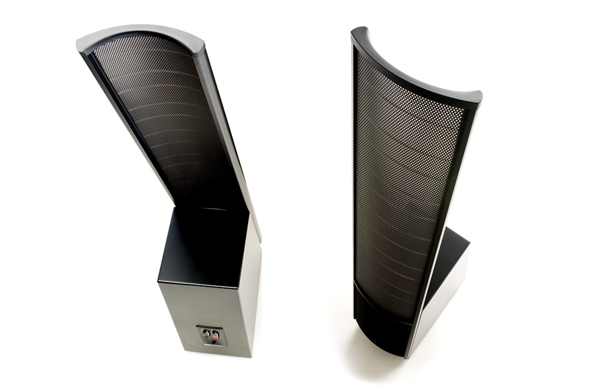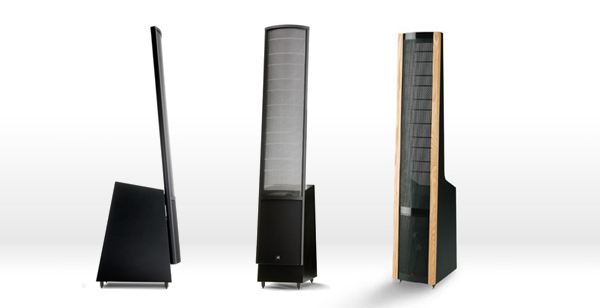 If you happen to be a music lover who adores electrostatic speakers, you no doubt have your favorites. And if MartinLogan is on your radar, its Aerius is definitely at the top of your list. Considering what an amazing value the Aerius offered back in 1992 for about $2000, the fact that MartinLogan has hit nearly the same price with its ElectroMotion is nothing less than a major miracle in 2011.
If you happen to be a music lover who adores electrostatic speakers, you no doubt have your favorites. And if MartinLogan is on your radar, its Aerius is definitely at the top of your list. Considering what an amazing value the Aerius offered back in 1992 for about $2000, the fact that MartinLogan has hit nearly the same price with its ElectroMotion is nothing less than a major miracle in 2011.
When discussions about the ElectroMotion ESL began last fall, MartinLogan’s product manager Devin Zell couldn’t have been more enthusiastic. When he started telling me about the driver complement and fact that the company was trying to bring the speaker to market close to $2,000, I immediately thought of the Aerius. Zell, pleased that I picked up on the strategy, commented, “Exactly. We’ve had a number of product focus meetings and we’ve never quite been able to create a speaker like the Aerius for $2,000. Until now.” They came damn close – the EM-ESLs retail for $2,195
Of course that’s what marketing guys are supposed to say, but Zell put his money where his mouth is. “To prove just how amazing these speakers are, I’m going to send you a pair of Aerius i’s so you can compare them side by side.” Nothing like a man who walks it like he talks it.
Speaker Basics
The $2,195 ElectroMotion utilizes an 8-inch unamplified woofer and an ESL panel that uses the same “XStat MicroPerf” technology that is featured in MartinLogan’s top-of-the-line speakers. Thanks to such a design, the EM-ESL has about 40% more panel area than the Aerius, yet has a smaller footprint. The crossover uses ML’s latest technology, all trickled down from its flagship CLX speakers and a downward firing port.
The EM-ESL has a rated sensitivity of 91db and nominal impedance of 6 ohms, which dips to 1.6 ohms at 20khz, making the EM-ESL fairly tube-amplifier friendly. Switching from the Aerius i to the EM-ESL speakers with the PrimaLuna Dialog 4 power amplifier (EL34 output tubes, 40wpc), there wasn’t much perceived increase in output level even though the EM-ESL’s are allegedly 3db more sensitive. The additional bass control and HF extension became immediately apparent. Swapping back and forth between the two revealed the Aerius i to have a warmer, darker (richer to some) sound.
Save for binding posts, build quality is top-notch and worthy of a decent set of speaker cables. But those posts. Sourced from MartinLogan’s Motion 4 speakers, the only option is bare wire and banana plugs. Sure, MartinLogan had to sharpen the pencil to hit its price target, but most would happily pay an extra $100 to get proper binding posts.
Setup
Thanks to their smaller size and lighter weight (I’ve been using MartinLogan’s CLXs for some time, and they are much larger) the EM-ESL is easy to set up and can be easily accomplished with one person. They work well in a small-to-medium- sized room, but did an amazingly good job filling up my main 16 x 24 feet listening room. As with any panel speaker, the further you can keep them away from the sidewalls, the better, as doing so results in a wider stereo image. Fortunately, the EM-ESL’s small footprint allowed them to seamlessly integrate into my room better than any other panels I’ve tried since the MartinLogan Vantage.
Final placement ended up being about seven feet apart, slightly toed in with the ESL panels about 50 inches from the rear wall. While I spent a fair amount of time listening through PrimaLuna, CJ, and Octave power amplifiers I had on hand, the speakers’ limits were explored via the Burmester 011 preamplifier/911 mk. 3 power amplifier—the same combination through which I’ve auditioned MartinLogan’s CLX, Summit, and Summit X for nearly a year.
No, the average EM-ESL owner isn’t going to hook them up to a $60k power amplifier/preamplifier setup. But rest assured that these speakers weren’t embarrassed in the company of the Burmester gear, and yielded stellar performance. Finally, the EM-ESL’s spent the bulk of the review paired with Simaudio’s new 600i integrated amplifier. Yes, the tubes were great fun, and while the romance of the vacuum tubes appeal to some, a high-current solid-state amplifier coaxes maximum performance.
 Comparing Old and New
Comparing Old and New
I began comparison between the Aerius i and EM-ESL by playing “The Breeze,” from Lynyrd Skynyrd’s Second Helping. Hardcore audiophiles might scoff, yet Skynyrd albums actually reveal tons of information due to the band’s triple lead-guitar format. Not only did they impress with excellent imaging of each of the three guitarists, the speakers also dynamically portrayed the grungy guitar intro to “Sugar Buzz” off kd lang’s new Sing it Loud. While a fairly dense recording, the ElectroMotions had no difficulty keeping Lang front and center without ever losing the bite of the instruments.
Switching between the Aerius i’s and EM-ESL’s repeatedly revealed the latter’s tremendous refinement. Regardless of musical choice, the current model possessed an increased level of resolution that its predecessor couldn’t touch. When listening to primarily acoustic fare, the EM-ESL’s presented instruments with a more lifelike timbre and provided extra low-level detail. Craving exquisite? Experience the cymbal decay on the title track of Kenny Burrell’s Midnight Blue via these cost-defying loudspeakers. I constantly had the illusion that I was listening to significantly more expensive speakers.
What’s more, the EM-ESL really pulls ahead of its predecessor when playing rock. Where the Aerius always struggled, running out of dynamic punch at higher levels, the MicroPerf panel in the ElectroMotion plays much louder without hitting its limit. I first noticed this ability in MartinLogan’s Summit (the original as well as the Summit X); I could actually play Metallica at a level loud enough to qualify as immersive. While the EM-ESL can’t play as loud as the Summit, all but the most crazed metalheads should find satisfaction. I was never disappointed when going through a fair share of classic Led Zeppelin or prog-minded Tool.
ESLs aren’t famous for having a huge sweet spot, yet that of the EM-ESL is on par with ML’s much more expensive Vantage. Amazing. The other surprise? Bass performance. The EM-ESL’s go down solidly to the mid-40hz range and still have useable output below 40hz, although, it should noted, they are rolling off at this point.
Exceeds Expectations
The Aerius was an amazing speaker in its day and still holds up well, but the MartinLogan team has learned a lot in the last 15 years. I’m still stunned that a company can manufacture a speaker this good for $1,995 in 2011. Granted, an ESL is slightly more finicky than your average pair of cone speakers, but if there’s a more exciting loudspeaker out there at this price, I certainly haven’t heard it. While the year isn’t yet half over, the EM-ESL’s are on our short list for a Product of the Year award.
MartinLogan EM-ESL Speakers
MSRP: $2,195
Manufacturer Info: www.martinlogan.com
Peripherals
Amplifier Simaudio 600i
Digital Source Simaudio 750D
Analog Source Rega P9 w/RB1000 arm and Denon DL-103 cartridge, Parasound JC- phono preamp
Cable ED 411 ICs and 432 speaker cable
Power Running Springs Elgar














